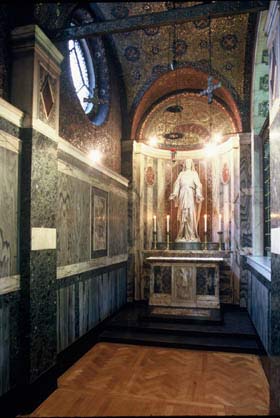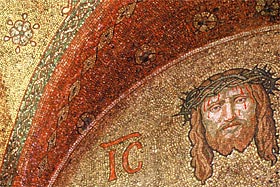Shrine of the Sacred Heart and St Michael

This small, narrow Chapel is a quiet place for solitude.

Mosaic interpretation of a painting of Christ
The Church celebrates the Feast of of SS Michael, Gabriel and Raphael, the Archangels, on 29 September. In the Cathedral, a small chapel dedicated to the Sacred Heart and St Michael the Archangel is one of the mostly richly decorated and yet least well-known.
The small place to the north of the Blessed Sacrament Chapel is very narrow in proportion to its length and terminates eastward in a small apse. The area is dominated by a large statue of the Sacred Heart of Jesus given by the Sisters of the Sacred Heart; the marbles in this Chapel were donated by those who were educated in their convent schools. The early Christian understanding of the Sacred Heart was based on an interpretation of John 7:37-39 and 19:33-37 which sees Jesus as the fountain dispensing the Spirit, the living water, from the Saviour’s pierced side. As the Church is born out of Christ’s wounds, endured in love, it is fitting that this place is a place of retreat for prayer.
The frontal of the altar is a sculpted bas-relief of St Michael slaying a dragon. The dragon has traditionally been understood to symbolise all the spiritual enemies of the Kingdom of Christ. The marble-work was begun early in 1910 and finished within six months. The red emphasised strongly in the mosaics themselves, is repeated in the altar slab of Cork marble, and the sculpture of St Michael each reminding us of the dedication of the Cathedral to the Precious Blood of Christ.
The retable carries a pedestal of campan vert on which stands the life-size statue of the Sacred Heart carved in the studios of Farmer & Brindley Co. The recess behind the figure is lined with vertical strips of black pandema, an extremely rare marble, brought from Asia-Minor by Farmer & Brindley in the 1880s.
The only pictorial element in this Chapel occurs at the west end above the oak door where we can see in the small tympanum the face of Christ gazing out. It is based on the last work of William Christian Symons and was completed shortly before his death in 1911. It was a gift of Mrs Evelyn Murray though not given without a sharp difference of opinion with the artist. She had been greatly impressed with representations of the Holy face in the Church of St Mary, Chelsea and the Jesuit Church at Farm Street. However, the artist, who was nearing the end of his life, produced images which clearly were meditations on the mystery of suffering.
It seems that Symons focused on the words of Our Lord ‘I thirst’. To retreat to this place of solitude, we are offered the opportunity to reflect on these words and know that Our Lord thirsts for prayer from each of us. It is in the wounds of Christ that we can glimpse the outpouring of love on the Cross and see the wonder of what is offered to each of us.
Based on extracts from Westminster Cathedral Building of Faith, published by Booth-Clibborn Editions.
